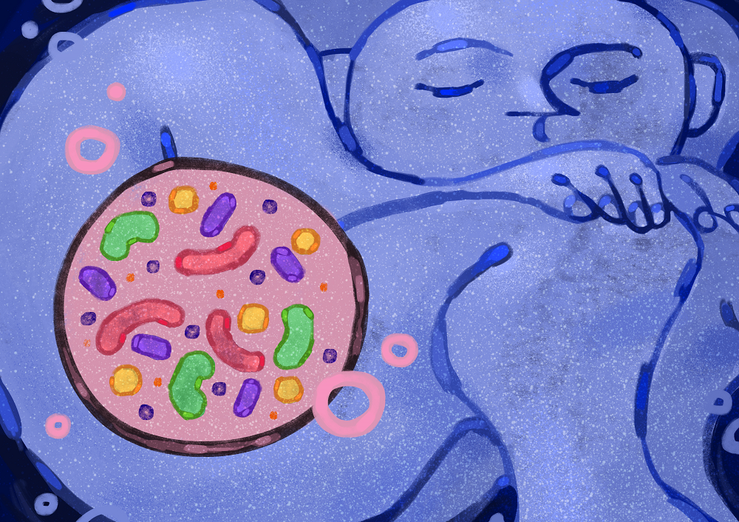
Микробиом человека
27 февраля 2024
Микробиом человека
- 567
- 1
- 6
Проект «Геном человека» показал, что вместо ожидавшихся 100 000 генов в нашей ДНК закодировано лишь 20 000... Где же остальные...?
Рисунок в полном размере.
-
Авторы
-
Редакторы
Обзор на конкурс «Био/Мол/Текст»: Краткий обзор проекта, проводившегося Национальными институтами здравоохранения США с 2007 по 2016 год.
Предлагаем ознакомиться читателю с кратким обзором инициативы «Микробиом человека», который мы выполнили в формате научного журнала. В обзоре описываются основные этапы проекта, наиболее часто используемые методы и ключевые результаты. Также дается оценка актуальности данных исследований как для научного сообщества, так и для широкой общественности.
Конкурс «Био/Мол/Текст»-2023/2024
Эта работа опубликована в номинации «Наглядно о ненаглядном» конкурса «Био/Мол/Текст»-2023/2024.

Генеральный партнер конкурса — международная инновационная биотехнологическая компания BIOCAD.

«Книжный» спонсор конкурса — «Альпина нон-фикшн»
Смотреть журнал по ссылке
Литература
- Микробиом кишечника: мир внутри нас;
- Rachel Mackelprang, Mark P. Waldrop, Kristen M. DeAngelis, Maude M. David, Krystle L. Chavarria, et. al.. (2011). Metagenomic analysis of a permafrost microbial community reveals a rapid response to thaw. Nature. 480, 368-371;
- Matthew Olsen, Rania Nassar, Abiola Senok, Abdulla Albastaki, John Leggett, et. al.. (2021). A pilot metagenomic study reveals that community derived mobile phones are reservoirs of viable pathogenic microbes. Sci Rep. 11;
- Delegou E., Karapiperis C., Zoe H., Chasapi A. (2022). Metagenomics of the built cultural heritage: microbiota characterization of the building materials of the holy aedicule of the holy sepulchre in jerusalem. Scientific cilture. 8, 59–83;
- Guadalupe Piñar, Caroline Poyntner, Hakim Tafer, Katja Sterflinger. (2019). A time travel story: metagenomic analyses decipher the unknown geographical shift and the storage history of possibly smuggled antique marble statues. Ann Microbiol. 69, 1001-1021;
- Pauline Luczynski, Karen-Anne McVey Neufeld, Clara Seira Oriach, Gerard Clarke, Timothy G. Dinan, John F. Cryan. (2016). Growing up in a Bubble: Using Germ-Free Animals to Assess the Influence of the Gut Microbiota on Brain and Behavior. IJNPPY. 19, pyw020;
- Aleksandar D. Kostic. (2022). The human microbiome: A coming of age story. Cell Host & Microbe. 30, 449-453;
- Georg K. Gerber. (2014). The dynamic microbiome. FEBS Letters. 588, 4131-4139;
- Hans-Curt Flemming, Stefan Wuertz. (2019). Bacteria and archaea on Earth and their abundance in biofilms. Nat Rev Microbiol. 17, 247-260;
- Xiao-Hua Zhang, Waqar Ahmad, Xiao-Yu Zhu, Jixiang Chen, Brian Austin. (2021). Viable but nonculturable bacteria and their resuscitation: implications for cultivating uncultured marine microorganisms. Mar Life Sci Technol. 3, 189-203;
- R.D. Sleator, C. Shortall, C. Hill. (2008). Metagenomics. Letters in Applied Microbiology. 47, 361-366;
- Микробные фармацевты внутри нас. Человеческий микробиом — спаситель и убийца;
- Yasir Bashir, Salam Pradeep Singh, Bolin Kumar Konwar. (2014). Metagenomics: An Application Based Perspective. Chinese Journal of Biology. 2014, 1-7;
- Olubukola Oluranti Babalola. (2010). Beneficial bacteria of agricultural importance. Biotechnol Lett. 32, 1559-1570;
- Aneta K. Urbanek, Waldemar Rymowicz, Aleksandra M. Mirończuk. (2018). Degradation of plastics and plastic-degrading bacteria in cold marine habitats. Appl Microbiol Biotechnol. 102, 7669-7678;
- Abolfazl S. Motahari, Guy Bresler, David N. C. Tse. (2013). Information Theory of DNA Shotgun Sequencing. IEEE Trans. Inform. Theory. 59, 6273-6289;
- Artur J. Sabat, Evert van Zanten, Viktoria Akkerboom, Guido Wisselink, Kees van Slochteren, et. al.. (2017). Targeted next-generation sequencing of the 16S-23S rRNA region for culture-independent bacterial identification - increased discrimination of closely related species. Sci Rep. 7;
- J Patel. (2001). 16S rRNA gene sequencing for bacterial pathogen identification in the clinical laboratory. Molecular Diagnosis. 6, 313-321;
- Yunhao Wang, Yue Zhao, Audrey Bollas, Yuru Wang, Kin Fai Au. (2021). Nanopore sequencing technology, bioinformatics and applications. Nat Biotechnol. 39, 1348-1365;
- M V Olson. (1993). The human genome project.. Proc. Natl. Acad. Sci. U.S.A.. 90, 4338-4344;
- Peter J. Turnbaugh, Ruth E. Ley, Micah Hamady, Claire M. Fraser-Liggett, Rob Knight, Jeffrey I. Gordon. (2007). The Human Microbiome Project. Nature. 449, 804-810;
- NIH Human Microbiome Portfolio Analysis Team. (2019). A review of 10 years of human microbiome research activities at the US National Institutes of Health, Fiscal Years 2007-2016. Microbiome. 7;
- The Integrative HMP (iHMP) Research Network Consortium. (2019). The Integrative Human Microbiome Project. Nature. 569, 641-648;
- V. M. Markowitz, I.-M. A. Chen, K. Palaniappan, K. Chu, E. Szeto, et. al.. (2012). IMG: the integrated microbial genomes database and comparative analysis system. Nucleic Acids Research. 40, D115-D122;
- R. Madupu, A. Richter, R. J. Dodson, L. Brinkac, D. Harkins, et. al.. (2012). CharProtDB: a database of experimentally characterized protein annotations. Nucleic Acids Research. 40, D237-D241;
- I. Pagani, K. Liolios, J. Jansson, I.-M. A. Chen, T. Smirnova, et. al.. (2012). The Genomes OnLine Database (GOLD) v.4: status of genomic and metagenomic projects and their associated metadata. Nucleic Acids Research. 40, D571-D579;
- Jesse Stombaugh, Jeremy Widmann, Daniel McDonald, Rob Knight. (2011). Boulder ALignment Editor (ALE): a web-based RNA alignment tool. Bioinformatics. 27, 1706-1707;
- Sitao Wu, Zhengwei Zhu, Liming Fu, Beifang Niu, Weizhong Li. (2011). WebMGA: a customizable web server for fast metagenomic sequence analysis. BMC Genomics. 12;
- Yongan Zhao, Haixu Tang, Yuzhen Ye. (2012). RAPSearch2: a fast and memory-efficient protein similarity search tool for next-generation sequencing data. Bioinformatics. 28, 125-126;
- J Gregory Caporaso, Christian L Lauber, Elizabeth K Costello, Donna Berg-Lyons, Antonio Gonzalez, et. al.. (2011). Moving pictures of the human microbiome. Genome Biol. 12, R50;
- S. Manfredo Vieira, M. Hiltensperger, V. Kumar, D. Zegarra-Ruiz, C. Dehner, et. al.. (2018). Translocation of a gut pathobiont drives autoimmunity in mice and humans. Science. 359, 1156-1161;
- Daniel N. Frank, Allison L. St. Amand, Robert A. Feldman, Edgar C. Boedeker, Noam Harpaz, Norman R. Pace. (2007). Molecular-phylogenetic characterization of microbial community imbalances in human inflammatory bowel diseases. Proc. Natl. Acad. Sci. U.S.A.. 104, 13780-13785;
- Vanessa Leone, Sean M. Gibbons, Kristina Martinez, Alan L. Hutchison, Edmond Y. Huang, et. al.. (2015). Effects of Diurnal Variation of Gut Microbes and High-Fat Feeding on Host Circadian Clock Function and Metabolism. Cell Host & Microbe. 17, 681-689;
- Eric A. Franzosa, Katherine Huang, James F. Meadow, Dirk Gevers, Katherine P. Lemon, et. al.. (2015). Identifying personal microbiomes using metagenomic codes. Proc. Natl. Acad. Sci. U.S.A.. 112;
- Lorna A. Seville, Andrea J. Patterson, Karen P. Scott, Peter Mullany, Michael A. Quail, et. al.. (2009). Distribution of Tetracycline and Erythromycin Resistance Genes Among Human Oral and Fecal Metagenomic DNA. Microbial Drug Resistance. 15, 159-166.






